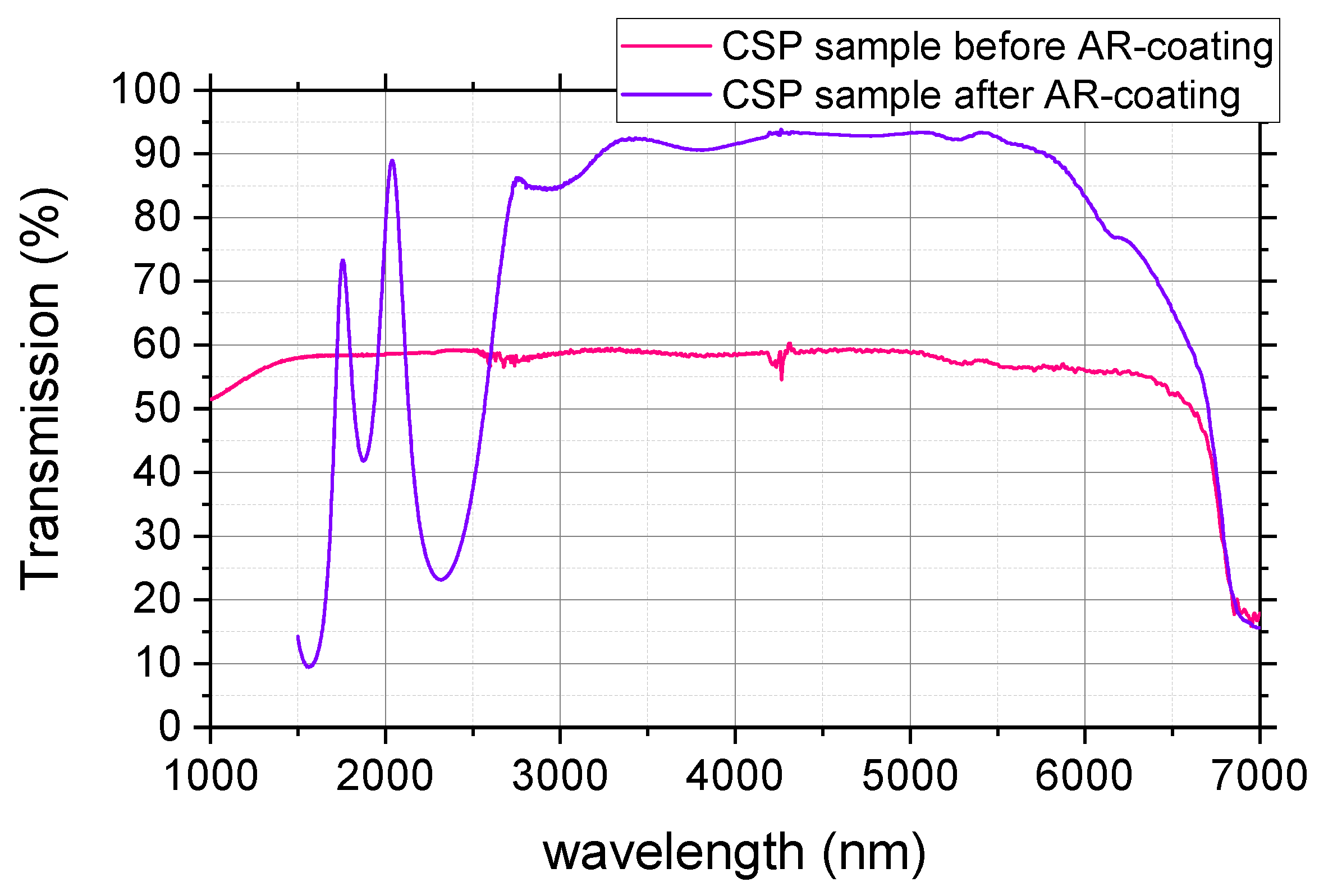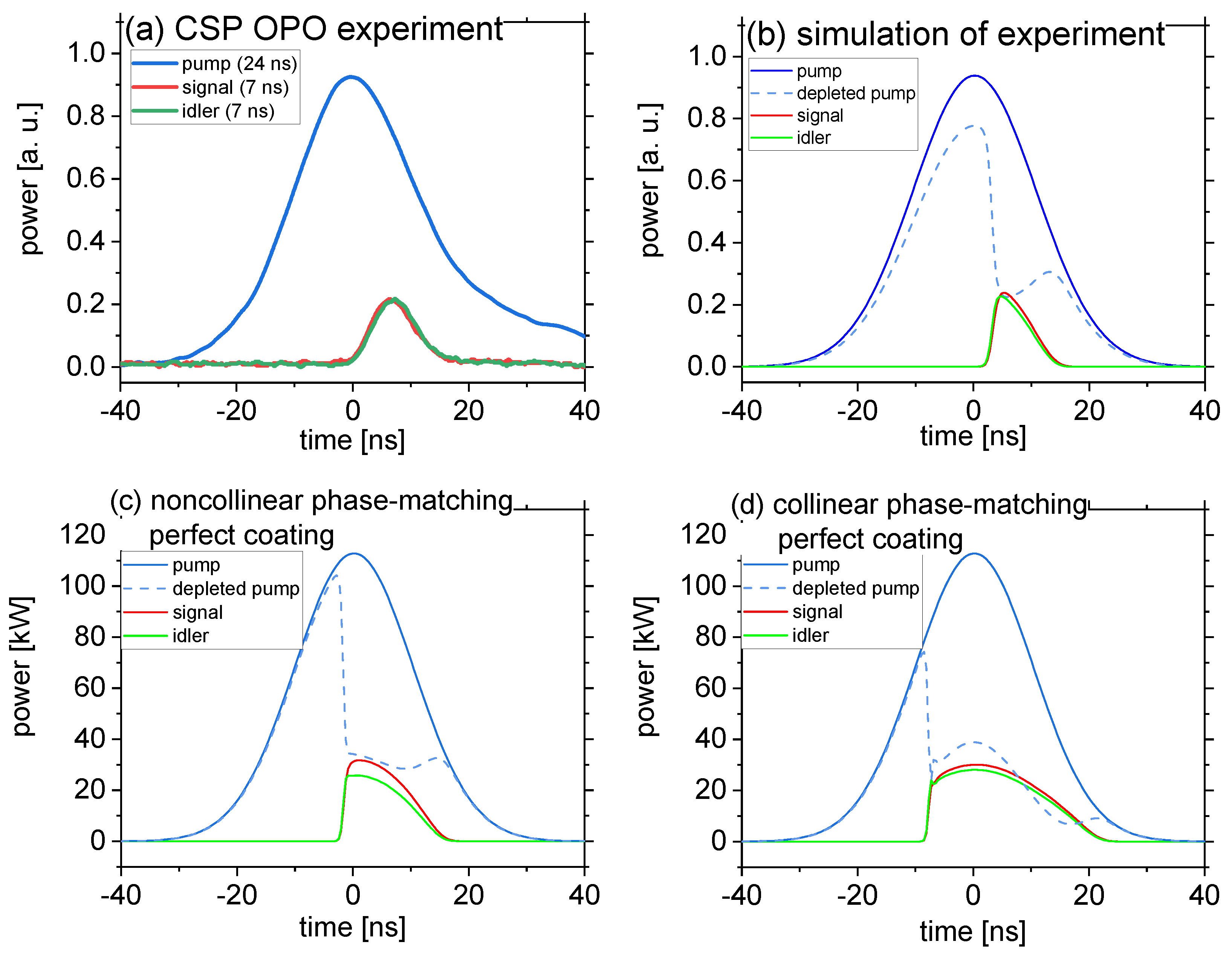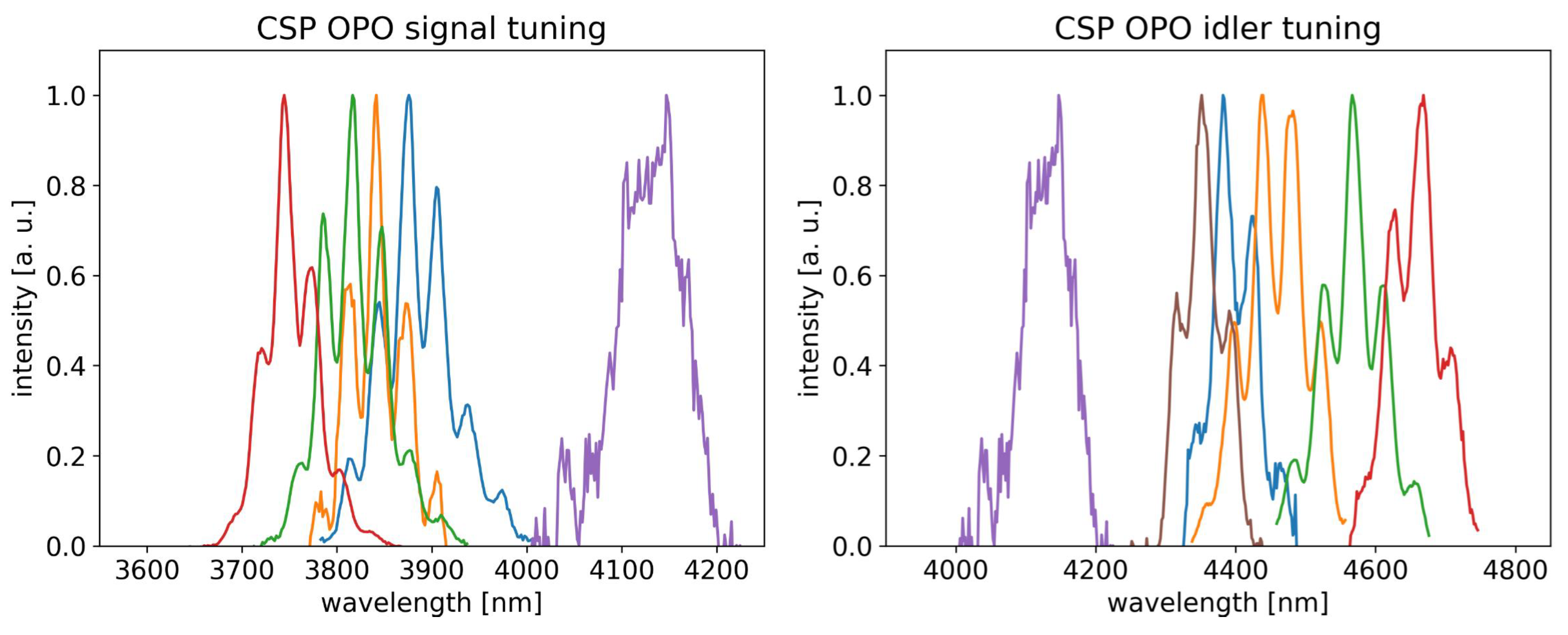CdSiP2 Optical Parametric Oscillator Pumped by a Nanosecond Ho:LLF Laser at 2.06 µm with Non-Collinear Phase-Matching
Abstract
1. Introduction
2. Experimental Setup
3. Results and Discussion
3.1. CSP OPO Conversion Efficiency and Numerical Simulation
3.2. Temporal Characteristics of Pulses
3.3. Beam Quality
3.4. OPO Wavelength Tuning
4. Conclusions
Author Contributions
Funding
Data Availability Statement
Acknowledgments
Conflicts of Interest
References
- Budni, P.A.; Pomeranz, L.A.; Lemons, M.L.; Miller, C.A.; Mosto, J.R.; Chicklis, E.P. Efficient mid-infrared laser using 1.9-µm-pumped Ho:YAG and ZnGeP2 optical parametric oscillators. J. Opt. Soc. Am. B 2000, 17, 723–728. [Google Scholar] [CrossRef]
- Vodopyanov, K.L.; Ganikhanov, F.; Maffetone, J.P.; Zwieback, I.; Ruderman, W. ZnGeP2 optical parametric oscillator with 3.8–12.4-µm tunability. Opt. Lett. 2000, 25, 841–843. [Google Scholar] [CrossRef] [PubMed]
- Schunemann, P.G.; Zawilski, K.T.; Pomeranz, L.A.; Creeden, D.J.; Budni, P.A. Advances in nonlinear optical crystals for mid-infrared coherent sources. J. Opt. Soc. Am. B 2016, 33, D36–D43. [Google Scholar] [CrossRef]
- Qian, C.P.; Yao, B.Q.; Zhao, B.R.; Liu, G.Y.; Duan, X.M.; Dai, T.Y.; Ju, Y.L.; Wang, Y.Z. High repetition rate 102 W middle infrared ZnGeP2 master oscillator power amplifier system with thermal lens compensation. Opt. Lett. 2019, 44, 715–718. [Google Scholar] [CrossRef]
- Petrov, V. Parametric down-conversion devices: The coverage of the mid-infrared spectral range by solid-state laser sources. Opt. Mater. 2012, 34, 536–554. [Google Scholar] [CrossRef]
- Zawilski, K.T.; Schunemann, P.G.; Pollak, T.C.; Zelmon, D.E.; Fernelius, N.C.; Kenneth Hopkins, F. Growth and characterization of large CdSiP2 single crystals. J. Cryst. Growth 2010, 312, 1127–1132. [Google Scholar] [CrossRef]
- Abrahams, S.; Bernstein, J. Luminescent piezoelectric CdSiP2: Normal probability plot analysis, crystal structure, and generalized structure of the AIIBIV family. J. Chem. Phys. 1971, 55, 796–803. [Google Scholar] [CrossRef]
- Petrov, V.; Noack, F.; Tunchev, I.; Schunemann, P.; Zawilski, K. The nonlinear coefficient d36 of CdSiP2. In Proceedings of the Nonlinear Frequency Generation and Conversion: Materials, Devices, and Applications VIII. SPIE, San Jose, CA, USA, 27–29 January 2009; Volume 7197, p. 71970M. [Google Scholar] [CrossRef]
- Kato, K.; Umemura, N.; Petrov, V. Sellmeier and thermo-optic dispersion formulas for CdSiP2. J. Appl. Phys. 2011, 109, 116104. [Google Scholar] [CrossRef]
- Kemlin, V.; Boulanger, B.; Petrov, V.; Segonds, P.; Ménaert, B.; Schunneman, P.G.; Zawilski, K.T. Nonlinear, dispersive, and phase-matching properties of the new chalcopyrite CdSiP2 [Invited]. Opt. Mater. Express 2011, 1, 1292–1300. [Google Scholar] [CrossRef]
- Hildenbrand, A.; Kieleck, C.; Tyazhev, A.; Marchev, G.; Stöppler, G.; Eichhorn, M.; Schunemann, P.G.; Panyutin, V.L.; Petrov, V.P. Laser damage of the nonlinear crystals CdSiP2 and ZnGeP2 studied with nanosecond pulses at 1064 and 2090 nm. Opt. Eng. 2014, 53, 122511. [Google Scholar] [CrossRef]
- Wei, J.; Murray, J.M.; Hopkins, F.K.; Krein, D.M.; Zawilski, K.T.; Schunemann, P.G.; Guha, S. Measurement of refractive indices of CdSiP2 at temperatures from 90 to 450 K. Opt. Mater. Express 2018, 8, 235–244. [Google Scholar] [CrossRef]
- Ferdinandus, M.R.; Gengler, J.J.; Averett, K.L.; Zawilski, K.T.; Schunemann, P.G.; Liebig, C.M. Nonlinear optical measurements of CdSiP2 at near and mid-infrared wavelengths. Opt. Mater. Express 2020, 10, 2066–2074. [Google Scholar] [CrossRef]
- Peremans, A.; Lis, D.; Cecchet, F.; Schunemann, P.G.; Zawilski, K.T.; Petrov, V. Noncritical singly resonant synchronously pumped OPO for generation of picosecond pulses in the mid-infrared near 6.4 µm. Opt. Lett. 2009, 34, 3053–3055. [Google Scholar] [CrossRef] [PubMed][Green Version]
- Chalus, O.; Schunemann, P.G.; Zawilski, K.T.; Biegert, J.; Ebrahim-Zadeh, M. Optical parametric generation in CdSiP2. Opt. Lett. 2010, 35, 4142–4144. [Google Scholar] [CrossRef] [PubMed]
- Petrov, V.; Marchev, G.; Schunemann, P.G.; Tyazhev, A.; Zawilski, K.T.; Pollak, T.M. Subnanosecond, 1 kHz, temperature-tuned, noncritical mid-infrared optical parametric oscillator based on CdSiP2 crystal pumped at 1064 nm. Opt. Lett. 2010, 35, 1230–1232. [Google Scholar] [CrossRef] [PubMed]
- Kumar, S.C.; Agnesi, A.; Dallocchio, P.; Pirzio, F.; Reali, G.; Zawilski, K.T.; Schunemann, P.G.; Ebrahim-Zadeh, M. Compact, 1.5 mJ, 450 MHz, CdSiP2 picosecond optical parametric oscillator near 6.3 µm. Opt. Lett. 2011, 36, 3236–3238. [Google Scholar] [CrossRef]
- Carnio, B.N.; Zawilski, K.T.; Schunemann, P.G.; Moutanabbir, O.; Elezzabi, A.Y. Generation of 17–32 THz radiation from a CdSiP2 crystal. Opt. Lett. 2023, 48, 1200–1203. [Google Scholar] [CrossRef]
- Kumar, S.C.; Schunemann, P.G.; Zawilski, K.T.; Ebrahim-Zadeh, M. Advances in ultrafast optical parametric sources for the mid-infrared based on CdSiP2. J. Opt. Soc. Am. B 2016, 33, D44–D56. [Google Scholar] [CrossRef]
- Marchev, G.; Tyazhev, A.; Petrov, V.; Schunemann, P.G.; Zawilski, K.T.; Stöppler, G.; Eichhorn, M. Optical parametric generation in CdSiP2 at 6.125 µm pumped by 8 ns long pulses at 1064 nm. Opt. Lett. 2012, 37, 740–742. [Google Scholar] [CrossRef]
- Schunemann, P.G.; Pomeranz, L.A.; Zawilski, K.T.; Wei, J.; Gonzalez, L.P.; Guha, S.; Pollak, T.M. Efficient mid-infrared optical parametric oscillator based on CdSiP2. In Proceedings of the Frontiers in Optics 2009/Laser Science XXV/Fall 2009 OSA Optics & Photonics Technical Digest, San Jose, CA, USA, 11–15 October 2009; p. AWA3. [Google Scholar] [CrossRef]
- Pomeranz, L.; McCarthy, J.; Day, R.; Zawilski, K.; Schunemann, P. Efficient, 2–5 µm tunable CdSiP2 optical parametric oscillator pumped by a laser source at 1.57 µm. Opt. Lett. 2018, 43, 130–133. [Google Scholar] [CrossRef] [PubMed]
- Cole, B.; Goldberg, L.; Chinn, S.; Pomeranz, L.A.; Zawilski, K.T.; Schunemann, P.G.; McCarthy, J. Compact and efficient mid-IR OPO source pumped by a passively Q-switched Tm:YAP laser. Opt. Lett. 2018, 43, 1099–1102. [Google Scholar] [CrossRef]
- Horton, S.L.; Pomeranz, L.A.; Zawilski, K.T.; Schunemann, P.; Liebig, C.; Averett, K.; Setzler, S. A 27 W CdSiP2 Optical Parametric Oscillator Pumped by a Q-Switched Ho: YAG Laser. In Proceedings of the Laser Congress 2020 (ASSL, LAC), Virtual, 13–16 October 2020; p. AF2A.2. [Google Scholar] [CrossRef]
- Piotrowski, M.; Medina, M.A.; Schellhorn, M.; Spindler, G.; Hildenbrand-Dhollande, A. Effects of pump pulse energy and repetition rate on beam quality in a high-power mid-infrared ZnGeP2 OPO. Opt. Express 2021, 29, 2577–2586. [Google Scholar] [CrossRef] [PubMed]
- Scherrer, E.M.; Kananen, B.E.; Golden, E.M.; Hopkins, F.K.; Zawilski, K.T.; Schunemann, P.G.; Halliburton, L.E.; Giles, N.C. Defect-related optical absorption bands in CdSiP2 crystals. Opt. Mater. Express 2017, 7, 658–664. [Google Scholar] [CrossRef]
- Gustafson, T.D.; Giles, N.C.; Scherrer, E.M.; Zawilski, K.T.; Schunemann, P.G.; Averett, K.L.; Slagle, J.E.; Halliburton, L.E. Residual optical absorption from native defects in CdSiP2 crystals. Opt. Mater. Express 2024, 14, 293–303. [Google Scholar] [CrossRef]
- Schellhorn, M.; Spindler, G.; Eichhorn, M. Mid-infrared ZGP OPO with divergence compensation and high beam quality. Opt. Express 2018, 26, 1402–1410. [Google Scholar] [CrossRef] [PubMed]
- Piotrowski, M.; Schellhorn, M.; Spindler, G.; Medina, M.A.; Müller, C.W.; Bigotta, S.; Hildenbrand-Dhollande, A. Polarisation compensation in non-planar image-rotating OPO ring resonators. Opt. Express 2023, 31, 13226–13242. [Google Scholar] [CrossRef] [PubMed]
- Naraniya, O.P.; Shenoy, M.; Thyagarajan, K. Efficiency improvement in MgO:PPLN based optical parametric generation using soft-edge top-hat transverse intensity profile for the pump beam. Opt. Commun. 2014, 316, 74–79. [Google Scholar] [CrossRef]
- Fleck, J.A.; Feit, M.D. Beam propagation in uniaxial anisotropic media. J. Opt. Soc. Am. 1983, 73, 920–926. [Google Scholar] [CrossRef]
- Siegman, A.E. How to (Maybe) Measure Laser Beam Quality. In DPSS (Diode Pumped Solid State) Lasers: Applications and Issues; Optical Society of America: Washington, DC, USA, 1998; p. MQ1. [Google Scholar] [CrossRef]






Disclaimer/Publisher’s Note: The statements, opinions and data contained in all publications are solely those of the individual author(s) and contributor(s) and not of MDPI and/or the editor(s). MDPI and/or the editor(s) disclaim responsibility for any injury to people or property resulting from any ideas, methods, instructions or products referred to in the content. |
© 2024 by the authors. Licensee MDPI, Basel, Switzerland. This article is an open access article distributed under the terms and conditions of the Creative Commons Attribution (CC BY) license (https://creativecommons.org/licenses/by/4.0/).
Share and Cite
Piotrowski, M.; Spindler, G.; Bogas-Droy, A.; Hildenbrand-Dhollande, A. CdSiP2 Optical Parametric Oscillator Pumped by a Nanosecond Ho:LLF Laser at 2.06 µm with Non-Collinear Phase-Matching. Photonics 2024, 11, 1190. https://doi.org/10.3390/photonics11121190
Piotrowski M, Spindler G, Bogas-Droy A, Hildenbrand-Dhollande A. CdSiP2 Optical Parametric Oscillator Pumped by a Nanosecond Ho:LLF Laser at 2.06 µm with Non-Collinear Phase-Matching. Photonics. 2024; 11(12):1190. https://doi.org/10.3390/photonics11121190
Chicago/Turabian StylePiotrowski, Marcin, Gerhard Spindler, Achille Bogas-Droy, and Anne Hildenbrand-Dhollande. 2024. "CdSiP2 Optical Parametric Oscillator Pumped by a Nanosecond Ho:LLF Laser at 2.06 µm with Non-Collinear Phase-Matching" Photonics 11, no. 12: 1190. https://doi.org/10.3390/photonics11121190
APA StylePiotrowski, M., Spindler, G., Bogas-Droy, A., & Hildenbrand-Dhollande, A. (2024). CdSiP2 Optical Parametric Oscillator Pumped by a Nanosecond Ho:LLF Laser at 2.06 µm with Non-Collinear Phase-Matching. Photonics, 11(12), 1190. https://doi.org/10.3390/photonics11121190




